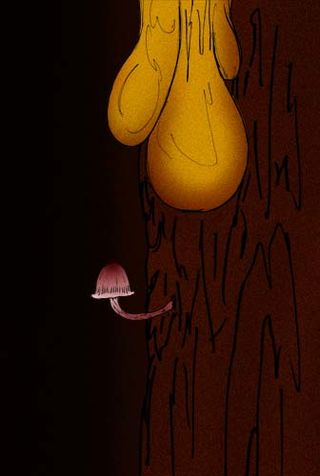
Dominican amber is amber from the Dominican Republic derived from resin of the extinct tree Hymenaea protera.

The family Oedemeridae is a cosmopolitan group of beetles commonly known as false blister beetles, though some recent authors have coined the name pollen-feeding beetles. There are some 100 genera and 1,500 species in the family, mostly associated with rotting wood as larvae, though adults are quite common on flowers. The family was erected by Pierre André Latreille in 1810.

Lechytia is a genus of pseudoscorpions in the subfamily Lechytiinae within the family Chthoniidae. It is the sole genus in its subfamily and contains 22 described species from many parts of the world.

Chthoniidae is a family of pseudoscorpions within the superfamily Chthonioidea. The family contains more than 600 species in about 30 genera. Fossil species are known from Baltic, Dominican, and Burmese amber. Chthoniidae now includes the former families Tridenchthoniidae, and Lechytiidae which has been demoted to subfamilies.

Protomycena is an extinct monotypic genus of gilled fungus in the family Mycenaceae, of order Agaricales. At present it contains the single species Protomycena electra, known from a single specimen collected in an amber mine in the Cordillera Septentrional area of the Dominican Republic. The fruit body of the fungus has a convex cap that is 5 mm (0.2 in) in diameter, with distantly spaced gills on the underside. The curved stipe is smooth and cylindrical, measuring 0.75 mm (0.030 in) thick by 10 mm (0.39 in) long, and lacks a ring. It resembles extant species of the genus Mycena. Protomycena is one of only five known agaric fungus species known in the fossil record and the second to be described from Dominican amber.

Lutzomyia adiketis is an extinct species of sandfly in the moth fly subfamily Phlebotominae. L. adiketis is a vector of the extinct Paleoleishmania neotropicum and both species are solely known from early Miocene Burdigalian stage Dominican amber deposits on the island of Hispaniola.

The Brachypsectridae are a family of beetles commonly known as the Texas beetles. There are only two extant genera, Brachypsectra and Asiopsectra. Brachypsectra has a cosmopolitan distribution, mostly in arid regions, while Asiopsectra is found in Central Asia and the Middle East.
Termitaradus avitinquilinus is an extinct species of termite bug in the family Termitaphididae known from several possibly Miocene fossils found in the Dominican Republic. T. avitinquilinus is the first species in the genus Termitaradus to have been described from fossils found in Dominican amber and is one of four species from New World amber, the others being Termitaradus protera, Termitaradus dominicanus and Termitaradus mitnicki.

Acropyga glaesaria is an extinct species of ant in the subfamily Formicinae known from a group of possibly Miocene fossils found on Hispaniola. A. glaesaria is the first species of the ant genus Acropyga to have been described from fossils found in Dominican amber and is the one of several species of Acropyga found in the West Indies. As with other members of the genus, A. glaesaria was most likely trophobiotic.

Anochetus conisquamis is an extinct species of ant in the subfamily Ponerinae known from one possibly Miocene fossil found on Hispaniola. A. conisquamis is one of eight species in the ant genus Anochetus to have been described from fossils found in Dominican amber and is one of a number of Anochetus species found in the Greater Antilles.

Anochetus corayi is an extinct species of ant in the subfamily Ponerinae known from one possibly Miocene fossil found on Hispaniola. A. corayi is one of eight species in the ant genus Anochetus to have been described from fossils found in Dominican amber and is one of a number of Anochetus species found in the Greater Antillies.

Anochetus lucidus is an extinct species of ant in the subfamily Ponerinae known from two possibly Miocene fossils found on Hispaniola. A. lucidus is one of eight species in the ant genus Anochetus to have been described from fossils found in Dominican amber and is one of a number of Anochetus species found in the Greater Antillies.
Anelaphus velteni is an extinct species of beetle in the family Cerambycidae that was found in the present-day Dominican Republic.
Plectromerus grimaldii is an extinct species of beetle in the family Cerambycidae.
Plectromerus tertiarius is an extinct species of beetle in the family Cerambycidae.
Apterostigma electropilosum is an extinct species of ant in the subfamily Myrmicinae known from a single possibly Miocene fossil found on Hispaniola. A. electropilosum is one of only two species of the ant genus Apterostigma and one of five attini species to have been described from fossils found in Dominican amber.
Apterostigma eowilsoni is an extinct species of ant in the subfamily Myrmicinae known from a single possibly Miocene fossil found on Hispaniola. A. eowilsoni is one of only two species of the ant genus Apterostigma and one of five attini species of to have been described from fossils found in Dominican amber.

Azteca alpha is an extinct species of ant in the subfamily Dolichoderinae known from possibly Miocene fossils found on Hispaniola. A. alpha is one of only two species in the genus Azteca to have been described from fossils, both found in Dominican amber. It is the host for a fossil nematode, and has been preserved with scale insects.
Azteca eumeces is an extinct species of ant in the subfamily Dolichoderinae known from possibly Miocene fossils found on Hispaniola. A. eumeces is one of only two species in the ant genus Azteca to have been described from fossils, both found in Dominican amber.
2015 in paleoentomology is a list of new fossil insect taxa that were described during the year 2015, as well as other significant discoveries and events related to paleoentomology that were scheduled to occur during the year.











